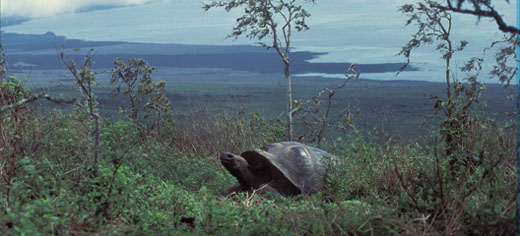 FIGURE 20
FIGURE 20
A Galápagos tortoise most closely resemble South American tortoises. Isolated on these remote islands, the Galápagos tortoise has evolved distinctive forms. This natural experiment is being terminated, however. Since Darwin’s time, much of the natural habitat of the larger islands has been destroyed by human intrusion. Goats introduced by settlers, for example, have drastically altered the vegetation. Darwin and Patterns of Recent Divergence
Darwin was the first to present evidence that animals and plants living on oceanic islands resemble most closely the forms on the nearest continenta relationship that only makes sense as reflecting common ancestry. The Galápagos turtle in figure 22.20 is more similar to South American turtles than to those of any other continent. This kind of relationship strongly suggests that the island forms evolved from individuals that came from the adjacent mainland at some time in the past. Thus, the Galápagos finches of figure 22.8 have different beaks than their South American relatives. In the absence of evolution, there seems to be no logical explanation of why individual kinds of island plants and animals would be clearly related to others on the nearest mainland, but still have some divergent features. As Darwin pointed out, this relationship provides strong evidence that macroevolution has occurred.
A similar resemblance to mainland birds can be seen in an island finch Darwin never saw — a solitary finch species living on Cocos Island, a tiny, remote volcanic island located 630 kilometers to the northeast of the Galápagos. This finch does not resemble the finches of Europe, Australia, Africa, or North America. Instead, it resembles the finches of Costa Rica, 500 kilometers to the east.
Of course, because of adaptation to localized habitats, island forms are not identical to those on the nearby continents. The turtles have evolved different shell shapes, for example; those living in moist habitats have dome-shaped shells while others living in dry places have low, saddle-backed shells with the front of the shell bent up to expose the head and neck. Similarly, the Galápagos finches have evolved from a single presumptive ancestor into 13 species, each specialized in a different way. These Galápagos turtles and finches have evolved in concert with the continental forms, from the same ancestors, but the two lineages have diverged rather than converged.
It is fair to ask how Darwin knew that the Galápagos turtles and finches do not represent the convergence of unrelated island and continental forms (analogs) rather than the divergence of recently isolated groups (homologs). While either hypothesis would argue for natural selection, Darwin chose divergence of homologs as by far the simplest explanation, because the turtles and finches differ by only a few traits, and are similar in many.
In sum total, the evidence for macroevolution is overwhelming. In the next chapter, we will consider Darwin’s proposal that microevolutionary changes have led directly to macroevolutionary changes, the key argument in his theory that evolution occurs by natural selection.
Evolution favors similar forms under similar circumstances. Convergence is the evolution of similar forms in different lineages when exposed to the same selective pressures. Divergence is the evolution of different forms in the same lineage when exposed to different selective pressures.
©Txtwriter Inc.